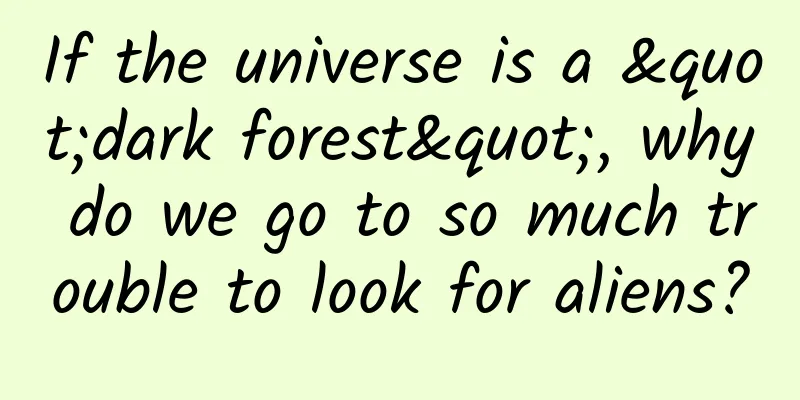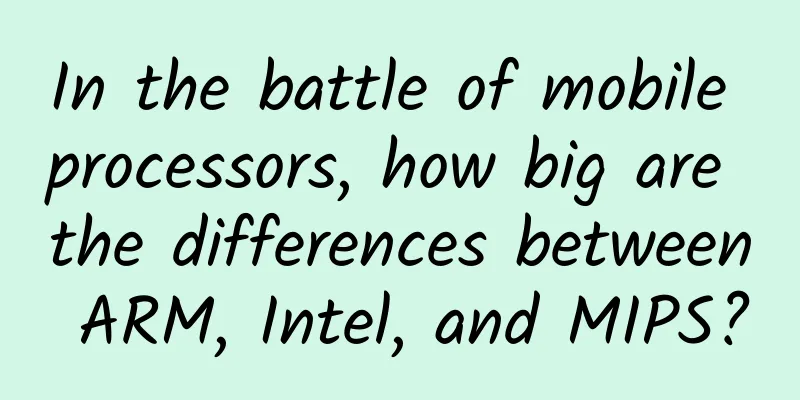If the universe is a "dark forest", why do we go to so much trouble to look for aliens?

|
Text|Li Yuebai and Jiang Xiaoyuan Recently, news about UFOs, extraterrestrial amino acids and other things related to the search for extraterrestrial life have frequently become hot topics. It has been more than 60 years since astronomer Drake launched the first SETI (Search for Extra-Terrestrial Intelligence) project in human history in 1960. In the past 60 years, what efforts have humans made to find aliens? What signals have been received? Why are scientists like Drake and Carl Sagan so enthusiastic about finding aliens, while scientists like Hawking and Brin are strongly opposed? After listening to Liu Cixin's explanation of the "Dark Forest" in "The Three-Body Problem II", do you agree with the search for aliens? The History of SETI - From a Science Fiction Movie In 1997, a science fiction movie called "Contact" was released in the United States. The heroine of the movie, Ellie, has been curious about the universe since she was a child, and grows up to become an excellent astrophysicist. She is committed to the SETI activity of searching for aliens and has devoted her whole heart and soul to this long-shot cause. One evening, Ellie heard a special, beautiful and regular signal in her headphones. After identification, she found that the signal came from Vega, 26 light-years away from the Earth. Human beings finally received the message from alien civilization. Faced with the vast universe, curiosity and pursuit of equally intelligent life are natural to human beings. The screenwriter of the movie "Contact" - American astrophysicist and science fiction writer Carl Sagan is one of the main initiators of SETI in reality. Carl Sagan's imagination and expectations of extraterrestrial civilizations are well-intentioned. His famous saying, "If we are the only one in the universe, it would be a waste of space," runs through the beginning, middle and end of this film. The main method of SETI is to receive electromagnetic waves from the universe through advanced equipment such as radio telescopes, and analyze regular signals from them in the hope of discovering extraterrestrial civilizations. The principle that SETI believes in is that if alien technology develops to a certain stage, they may use radio waves to convey information like us (such as inventing television, radar, etc.), so that trace amounts of radiation will leak out from the planet they live on. In addition, aliens may consciously send signals into the universe in the hope of communicating with other intelligent life. What we have to do is to identify the signals of alien civilizations from the cosmic background filled with various radiations. When talking about SETI activities, we always have to mention Frank Drake, who is a more important pioneer than Carl Sagan. In 1960, American astronomer Drake launched the first SETI project in human history, Project Ozma, which was named after the fairy tale The Wizard of Oz. Although Frank had a beautiful vision for "Ozma", there were considerable problems with the planned operation. First of all, Frank only had a 26-meter radio telescope at the time (which was really insignificant compared with the 500-meter aperture spherical radio telescope of the "China Sky Eye"). Since it was impossible to scan the entire sky, where should the telescope point? The more critical question is, which frequency should we choose to monitor? When we use the radio, we know that if the frequency is not adjusted correctly, we can't receive the radio station and can only hear noise. But it is difficult for us to know which frequency the aliens choose to transmit signals. Finally, Drake aimed the telescope at Tau in Cetus and Epsilon in Eridanus. These two stars are similar to the Sun and are 10.5 light-years and 12 light-years away from the Earth, respectively. The monitoring frequency was finally determined to be 1420.405 MHz. Drake and other scientists agreed that this frequency was quite special and was probably the preferred frequency for aliens to send messages to space, because this was the electromagnetic wave frequency emitted by the most abundant hydrogen atoms in the universe, and most alien civilizations with radio telescope technology could detect signals of this frequency. Drake's team monitored the two galaxies for about 150 hours and, apart from receiving two signals from aircraft, did not intercept any information from aliens. The first SETI experiment in human history has failed. After that, other larger-scale SETI projects were launched one after another, such as the "Big Ear" SETI project launched in Ohio in 1973 and the "Phoenix" SETI project launched in 1995. From Passive to Active: Sending Messages to Aliens Since curiosity about other life in the universe is natural to human beings, there are always some "bold people" who want to take more proactive measures. As early as when SETI lasted for ten years without any results, Sagan and others could no longer hold back. How can we get in touch with extraterrestrial civilizations as soon as possible? That is, actively sending our message to space. "If the mountain does not come to me, I will go to the mountain." In 1972 and 1973, the United States launched two space probes, Pioneer 10 and Pioneer 11. The main detection targets of these two probes were Jupiter and Saturn respectively. Unlike the series of "Pioneers" launched previously, No. 10 and No. 11 will fly out of the solar system and into the depths of the universe by relying on inertia after completing their exploration missions. What’s even more special is that both probes carry a special item - a gift from humans to aliens. This "gift" is essentially a very light gold-plated aluminum plate designed by Carl Sagan and Frank Drake and completed by Sagan's wife, in an attempt to use a painting to introduce our civilization and our planet to aliens. The most eye-catching thing in the picture is the image of two naked humans on Earth, a man and a woman. The man makes a "waving" gesture, which expresses friendliness in human body language. Next to the man is a rectangular pattern representing the outline of the Pioneer probe, the main purpose of which is to compare the size of the human body relative to the probe. In the upper left corner of the picture is an image of a spin transition within a hydrogen atom, which conveys the level of human civilization's understanding of the microscopic world. The radial pattern on the left represents the pulse signal period of 14 pulsars in the Milky Way. The length of the lines in the pattern represents the distance of these pulsars relative to the solar system. Once aliens understand this image, they can infer the launch time of the probe and find the specific location of the solar system in the Milky Way. This gift has essentially completely exposed our coordinates. This is not the first time that humans have taken the initiative to "send gifts" to space. In August and September 1977, the United States launched two spacecraft, Voyager 1 and Voyager 2, each carrying a copper-plated gold laser disc with an estimated lifespan of 1 billion years. This record contains 115 pictures, 35 sounds of nature, oral greetings in nearly 60 languages of the world, 27 world-famous music pieces, etc. Among the nearly 60 greetings, there are Mandarin Chinese and three dialects: Minnan, Cantonese and Wu. The Chinese guqin piece "Liu Shui" played by Guan Pinghu was selected. Today, Pioneer 10 and 11 have lost contact, with the last information received being in 2003 and 1995 respectively. All we know is that the spacecraft has reached escape velocity and will leave the solar system forever. In September 2013, NASA announced that Voyager 1 had flown out of the solar system and entered interstellar space, and Voyager 2 was approaching the boundary of the solar system. But the nuclear batteries of Voyager 1 and 2 are about to fail and we will lose contact forever. While the Pioneers and Voyagers were delivering gifts to space, Drake and Sagan did another thing - they used radio telescopes to actively send radio positioning signals into space, an act that can be considered "active SETI." Humanity's first "active SETI" operation took place in 1974, when Drake used the Arecibo telescope to send 1,679 bits of information to the "M13 Globular Cluster" 25,000 light-years away from Earth for three minutes. The "Arecibo Message" mainly contains seven parts, which were carefully written by Drake and Sagan. It uses the most basic numbers to express elements, uses the elements to form molecular formulas, and then uses molecular formulas to form life and humans, with layers of strict logical relationships. But many people doubt whether aliens can decipher the information. After all, aliens may have a completely different thinking pattern from humans on Earth, or in other words, they may be completely different from us. However, even if humans can really receive a reply from the "M13 Globular Cluster", it will be at least 50,000 years later. Since the launch of the "Arecibo Message", humans have carried out three larger-scale "active SETI" operations, namely "Cosmic Call 1999" (Russia), "Youth Message" (Russia) and "Cosmic Call 2003" (Russia, the United States, and Canada). The amount of information and transmission power of the last three transmissions were far greater than the "Arecibo Message" in 1974. In fact, whether it is shouting into the universe with a radio telescope or sending a spacecraft carrying earth information into space, both are attempts to actively contact extraterrestrial civilizations. This behavior is also called METI - "Message to the Extra Terrestrial Intelligence". The assumption is that aliens have not appeared yet because they are unaware of the existence of humans. If we actively send information about the Earth into the universe, the aliens will contact us after receiving it. Controversy: Should we actively send signals? Internationally, METI is a controversial activity, and there are many well-known people who are against METI. British radio astronomer Martin Ryle was one of the early opponents of METI. He warned that any alien lifeforms might be malicious and hungry, and that contacting them could result in death. At the same time, Ryle also wrote a letter to the International Astronomical Union, calling for an international ban specifically targeting those on Earth who attempt to establish contact with aliens or actively send signals to them. Another big figure who opposes METI is Stephen Hawking. In 2010, Hawking wrote and produced a documentary series, "Understanding the Universe with Hawking," which was broadcast on the Discovery Channel in the United States. The documentary consists of three episodes, one of which is devoted to discussing the issue of aliens. Hawking said that if we think in a purely mathematical way, we can conclude from the numbers that aliens must exist. Alien life should be diverse in form, and the possibility of evolving intelligent creatures that can threaten humans cannot be ruled out. These creatures may have learned the secret of immortality, exhausted the resources of their home planet, and embarked on the path of conquering the universe. They can even use stellar-level energy to directly tear apart space and create wormholes to reach predetermined targets for plunder. It is very dangerous for humans to actively seek contact with aliens. Once aliens come to Earth, it may be like Columbus discovering the Americas, and the result will certainly not be a good thing for the local Indians. Also opposing METI is David Brin, an American physicist who is more famous for writing science fiction novels. As to why aliens have not been contacted so far, Brin proposed an interesting theory called "The Great Silence." "If advanced extraterrestrial intelligent life chooses to remain silent, shouldn't we choose to do the same? Or at least wait and see? It's possible that they are silent because they know something we don't know," Brin said. Brin believes that there may be some dangers and rules in the universe that humans are not yet aware of that have led to the "Big Silence". The more sensible strategy at present is to adopt SETI rather than METI. Unlike the malicious inferences of Ryle, Hawking and others, METI supporters such as Carl Sagan and Satsheev have quite positive predictions about the outcome of contact. Satsheev believes that alien civilizations with more advanced technology must be "civilized" and will show friendliness and love to us, who are also rare intelligent beings in the universe. Satsheev even believes that aliens will impart knowledge and experience to us and save humanity from the dangers of nuclear weapons, war and environmental pollution. Contacting aliens is not only not an adventure, but also very necessary. It will play a vital "enlightenment" role in the development and continuation of human civilization. In Liu Cixin's science fiction novel The Three-Body Problem, Chinese scientist Ye Wenjie is also an avid supporter of extraterrestrial civilizations. After being arrested, she had the following conversation with her interrogator on Earth: (The following text is excerpted from Liu Cixin's "The Three-Body Problem I") "Interrogator: Do you know about the Trisolaran civilization? Ye Wenjie: I don’t know. The information we have is very limited. In fact, no one knows the true and detailed appearance of the Three-Body Civilization except Evans and other core members of the Advent Faction who intercepted the Three-Body information. Interrogator: Then why do you have such expectations of them, believing that they can transform and improve human society? Ye Wenjie: If they can cross the stars and come to our world, it means that their science has developed to a considerable level. A society with such advanced science must have a higher level of civilization and morality. Interrogator: Do you think this conclusion is scientific in itself? The interrogator's final question can be seen as the best rebuttal to those scientists who hope that alien civilization will come to act as savior. Think about how Westerners with advanced technology treat backward Indians and Africans, and it is not difficult to conclude that there is no positive correlation between the level of technological advancement and the level of civilization and morality. "Don't talk to aliens." Are there aliens in the universe? In 1961, when Drake presided over the first academic seminar on the search for extraterrestrial civilizations at an observatory near Green Bank, USA, he and the young Carl Sagan proposed the famous "Drake Formula" (also known as the Sagan Formula) to estimate the number of advanced civilizations in the Milky Way. Mathematically speaking, Drake's equation (N=R×Fp×Ne×Fl×Fi×Fc×L) shows that the probability of the existence of aliens in the universe is very high. The Earth is just one of the eight planets orbiting the Sun, and the Sun is just one of more than 200 billion stars in the Milky Way. If we look at the entire universe, the Milky Way is just one of the more than 100 billion galaxies and is not special. Even if humans are the only advanced civilization in the Milky Way (that is, the so-called N value is equal to 1), we cannot continue to be arrogant among more than 100 billion galaxies. This is what Hawking said, "With my mathematical mind, I can conclude from the numbers that aliens exist." "But where are they?" In the summer of 1950, Fermi also asked this question casually after breakfast one day. If aliens exist, they should have appeared long ago. Due to Fermi's great reputation, this casual question spread and became the famous "Fermi Paradox". Indeed, in just 300 years since the first industrial revolution, humans have landed on the moon and launched many satellites and spacecraft. Among them, Voyager 1 has flown out of the solar system and into the vast universe. If there is another civilization in the Milky Way with similar intelligence and development speed to ours, but was born 100 million years earlier than us, their colonial rule should have already spread throughout the entire Milky Way. Many scientists and science fiction writers around the world have tried to answer this question, among which the following are some of the most eye-catching explanations: The first explanation is that alien civilizations once existed, but they disappeared before they developed to the point where they could colonize interstellar space, for example, due to nuclear war, environmental pollution, and force majeure disasters. This explanation makes us think about how long can "civilization" survive? Is the current development of mankind unsustainable? Will we face the same fate in the near future? The second explanation is that we are the only intelligent civilization in the Milky Way. Even if there are more advanced civilizations in other galaxies, their influence cannot currently extend into the Milky Way. This means that humans are currently the race most likely to develop into a Type II civilization. If this historical mission is successfully completed, our descendants will be able to travel freely among the stars and eventually establish a vast galactic empire belonging to mankind in the Milky Way. The third explanation is that alien civilizations do exist, but they deliberately try to prevent us from discovering them. The Earth is a "laboratory" or even a "zoo" for aliens. They are silently observing us, trying to know what a civilization that grows spontaneously without any extraterrestrial influence will eventually look like. Therefore, no matter how much SETI and METI humans conduct, it will be in vain. In addition to the three explanations mentioned above, there are many other wonderful explanations. In recent years, Chinese writer Liu Cixin proposed another answer in "The Three-Body Problem II" - the "Dark Forest" law. This explanation is in the same vein as David Brin's "The Great Silence", but it is more sophisticated and more chilling. Liu Cixin's "Dark Forest" law is based on two basic axioms and two important concepts. The two basic axioms are: 1. Survival is the first need of civilization. 2. Civilization continues to grow and expand, but the total amount of matter in the universe remains the same. Two important concepts are: 1. Chain of suspicion. Because the universe is so vast and the distance between civilizations is so far, and because the speed of light cannot be exceeded, it is impossible for different civilizations in the universe to establish effective communication and mutual trust, which leads to the emergence of a "chain of suspicion." For example, if humans want to communicate with a civilization 100 light years away, it will take at least 200 years from sending a message to receiving a reply. How can we know what happened in the past 200 years? How much credibility do their responses and attitudes have? Since effective communication cannot be established, we cannot confirm whether the aliens are benevolent or malicious. Even if we believe they mean well, we have no way of knowing whether they see us as kind or malicious. Such a "chain of suspicion" can extend to infinity, with the result that no civilization can trust another civilization. 2. Technological Explosion Human civilization has a history of 5,000 years, but modern technology has only developed within 300 years. In terms of time scale, this is not development at all, but an explosion. Similarly, such a "technological explosion" may occur in any civilization, but it is unknown when it will happen. So, even if the technological level of the alien race that contacts us is far behind ours, they may experience a "technological explosion" at any time, quickly surpass us, and even threaten us! The picture of the universe outlined by these two basic principles and important concepts is: Civilizations in the universe must compete for resources with their own survival as their primary goal. They cannot trust another civilization, nor can they ensure that they are in a technologically advanced position. In this way, one, letting you know of my existence, and two, letting you continue to exist, are both dangerous to "me". This is the "dark forest" law of the universe, and it is also the reason for the collective "great silence" of extraterrestrial civilizations. "The universe is a dark forest. Every civilization is a hunter with a gun, sneaking through the forest like a ghost, gently pushing aside the branches that block the way, trying not to make any sound with his footsteps, and even breathing carefully: he must be careful, because there are hunters sneaking around like him everywhere in the forest. If he finds other life, no matter whether it is a hunter or not, no matter whether it is an angel or a devil, no matter whether it is a delicate baby or a staggering old man... there is only one thing he can do: shoot and destroy it. In this forest, others are hell, an eternal threat, and any life that exposes its existence will be quickly destroyed. This is the picture of cosmic civilization, and this is the explanation of the Fermi paradox." In general, Liu Cixin's warning to us is: "Don't talk to aliens." (The author Li Yuebai is a PhD in the history of science and technology and a librarian at the Qian Xuesen Library of Shanghai Jiao Tong University. Jiang Xiaoyuan is a professor at the School of Marxism of Shanghai Jiao Tong University) Editor | Li Yun Typesetting | Guo Gang |
<<: How many flowers and trees related to dad do you know?
>>: Low Earth orbit space is a "big treasure"
Recommend
Now that we have a direction, how should traditional media and emerging media be integrated?
Recently, Xi Jinping presided over the fourth mee...
4 rules for To B operations
We have been operating private domain traffic for...
What benefits will veterans receive in 2022? Is there a pension?
In July 2020, the Ministry of Veterans Affairs an...
Why was the chicken soup with Codonopsis pilosula fined? You may not know this important truth
Recently, a confinement center in Ningbo was fine...
ARM launches new GPU designed for wearables and IoT
ARM's media processor division recently relea...
Dianca raises 2 billion yuan, round A financing has started, and will launch a high-end brand
It is reported that Diancha Automobile recently c...
There are certain requirements for underwear fabrics. Which one is the true love of your butt?
Just as "there are a thousand Hamlets in the...
Who can stand someone shitting on their head??? Penguins can...
A few days ago, Xiaojun saw an animated picture o...
How to place advertisements in Juliang Qianchuan live broadcast room
Juliang Qianchuan builds video or live broadcast ...
The guy inserted a catheter into his own heart and won a Nobel Prize!
This article was first published by Hunzhi (WeCha...
"Taming" proteins in a test tube: directed evolution of enzymes
The continuation of life requires energy, and the...
Blind review of Xiaomi 8 and OnePlus 6 photo effects comparison, did you guess it right?
The official said that Xiaomi 8 has the best came...
How can we avoid risks in the face of heavy rain or even floods?
Affected by the northward movement of the remnant...
Baby Safe Medication Guide Upgraded Disease Care Guide
Baby's safe medication guide upgraded version...









